Coordinators:
?
Vega rings
Vega PDFs
Vega 1cy August
Vega 1cy September
Vega 1cy October
Vega 1cy November
Vega 1cy December
Vega 2cy January
Vega 2cy February
Vega 2cy March
Vega 2cy April
Vega 2cy May
Vega 2cy June
Vega 2cy July
Vega 2cy August
Vega 2cy September
Vega 2cy October
Vega 2cy November
Vega 2cy December
Vega 3cy January
Vega 3cy February
Vega 3cy March
Vega 3cy April
Vega 3cy May
Vega 3cy June
Vega 3cy July
Vega 3cy August
Vega 3cy September
Vega 3cy October
Vega 3cy November
Vega 3cy December
Vega sub-ad January
Vega sub-ad February
Vega sub-ad March
Vega sub-ad April
Vega sub-ad May
Vega sub-ad June
Vega sub-ad July
Vega sub-ad August
Vega sub-ad September
Vega sub-ad October
Vega sub-ad November
Vega sub-ad December
Vega ad January
Vega ad February
Vega ad March
Vega ad April
Vega ad May
Vega ad June
Vega ad July
Vega ad August
Vega ad September
Vega ad October
Vega ad November
Vega ad December
|
Vega Gull (vegae) juvenile / 1CY July - August
Do we finally go Vega - part I?
This little piece of text below is an attempt to see if there are any ways to identify Vega Gull when one drifts to Europe and ends up at a beach where the two taxa argentatus and argenteus flock in 1.000's in winter. For long (and some still do) Vega Gull was considered to be a subspecies of Herring Gull and the two are very similar in many respects. Therefore the aim of this text is to find birds that "show a combination of features which together strongly suggest Vega Gull". It is clear that much caution is needed and probably many Vega Gull will just go unnoticed when present between European Herrings. And equally true: features of interest are certainly not black/white, but subtle and many captions read that one taxon "more often shows..." or "has slightly less...", hence it's a matter of (personal and subjective) interpretation. After all these warnings for caution, it's still an interesting excercise.
It's been divided into three sections
1st cycle birds (below, this page)
2nd cycle & immature birds
adult birds
1st cycle / 1st winter birds
The focus is on winter plumage birds, for picking out a heavily worn or moulting individual is probably one step too far.
Immature Vega Gull vegae from NE Russia look extremely similar to European birds, and probably a set of scoring traits is necessary for a positive or even diagnostic identification. Still, Vega Gull may show larger individual variation than currently understood, and an unknown portion of 1st cycle Vega on Asian images appears to be too similar to Herring Gulls in the field.
Here are ten points which may be relevant in identification of 1st cycle Vega Gull. By discussing these points we may (or may not) be able to compose a diagnostic set, or at least some hierarchy in features:
- limited body and head moult in Vega; hence largely in juvenile conditions, which is blotchy brown in the lower neck and sides of the breast, not delicately streaked;
- although body moult is limited, it's common in Vega to show 2nd gen scapulars from December onwards, these 2nd gen scaps often include rather plain grey feathers with just a dark shaft streak or very ill-defined anchor pattern (rather plain feathers reminiscent of taxon European cachinnans; the anchor patterns on 2nd gen scaps in European Herrings are much bolder and pronounced);
- tertials in Vega are often obviously darker than the brown tone in the coverts, with only narrow pale fringes, lacking deep notching on the fringes. Tertials are the darkest part of the back in Vega (and are less contrasting in European Herring Gull);
- rather uniform and solid dark flanks in Vega (often widely spaced flank lines in European Herrings);
- tidy and pale looking wing-coverts and juvenile scapulars in Vega Gull;
- uppertail coverts more densely barred in Vega (widely spaced chevron pattern in European Herrings);
- rectrices with broader dark bands in Vega, especially outer tail-feather R6 with proximal barring and flecking (often narrower dark tail band in European Herrings and proximal half of R6 clean white or with single black spots);
- dark patch on head most solid on rear ear-coverts, continuing behind the eye upwards to the crown in Vega (delicately streaked crown in European Herrings, especially when head feathers have been moulted to 2nd generation the streaking appears as fine pencil lines);
- obvious pale panel on inner primaries, also on outerwebs in Vega Gull;
- legs may be rich raspberry pink in Vega Gull (flesh coloured in European Herrings).
These 10 points are open for discussion, and may change in due time.
We now illustrate these points with Vega and several example Herring Gulls. The images of Herring Gulls are selected on closely matching the features of Vega Gull, and do not show classic Herring Gulls in such aspects. For many more European birds see HERE. The issue to solve is gaining insight of the individual variation of both Vega and Herring Gulls in their first cycle. Next is the challenge to find multiple Vega traits in known Herring Gulls, or the impossibilty to do that, which would be great of course.
- limited body and head moult in 1st cycle Vega Gull.
Vega Gull is a bird breeding at northern latitudes, and, as may be expected for such taxa, many 1st cycle birds start relatively late with their post-juvenile moult. In other words, they retain the juvenile plumage for a long time. Any bird in November-December, which has replaced the scapulars and show extensive moult in the body feathers contradict to this general Vega picture; that would be odd for Vega by such date, but would be perfectly in line with Herring Gull.
The first two images below show a rather avergae Herring Gull argenteus. These images illustrate scapular moult and body and head moult.
|
 |
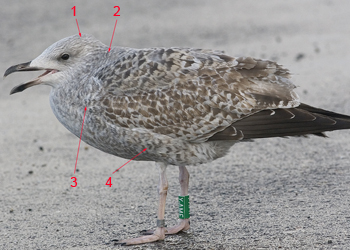 |
Herring Gull (argenteus) YAMF 1st cycle, August 13 2010 & December 09 2010, IJmuiden, the Netherlands (Mars Muusse). By August of its hatch year the bird is in juvenile plumage which is brown in neck (2), side of breast (3) and flanks (4), and all scapulars are still neat and fresh juvenile feathers.
Early December all these scaps have been replaced for 2nd gen feathers, and also feathers on the crown, neck, side of breast and flanks are different in the second image: now more delicately lined and streaked and the base colour is definitely greyish. These are now 2nd gen feathers, often still intermixed with old juvenile (brown) feathers. |
 |
 |
| Vega Gull (vegae) 1st cycle, November 15 2008, Nanba, Japan (Akimichi Ariga). By November still in fresh juvenile plumage. Note tertial pattern. |
Herring Gull (argentatus) 1st cycle, December 20 2015, Scheveningen, the Netherlands (Mars Muusse). Northern bird, with only few scaps replaced, but largely in juvenile plumage, also in head and body feathers. |
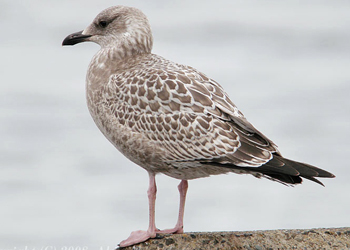 |
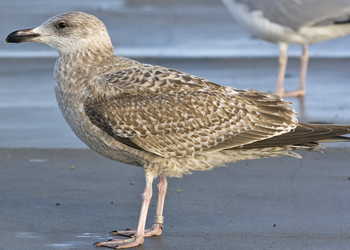 |
| Vega Gull (vegae) 1st cycle, November 15 2008, Nanba, Japan (Akimichi Ariga). By November still in fresh juvenile plumage. Note tertial pattern. |
Herring Gull (argentatus) 1st cycle RUM C-730184 December 09 2010, IJmuiden, the Netherlands (Mars Muusse). Hatched in Murmansk, N Russia (67,07N). Not all far northern birds are late in post-juvenile moult: here, upper scapulars replaced, lower scapulars still juvenile. Head and body moult very limited, just few feathers replaced. |
| |
|
- weak pattern on 2nd gen scapulars in 1st cycle Vega Gull.
Mid-winter 1st cycle Vega Gull has limited body and head moult (still largely juvenile) and the juvenile hindneck and sides of the breast are blotchy brown (not delicately streaked). Two images below illustrate this: left is Vega Gull and right is Herring Gull. Note the differences between the blotchy and delicate streaking.
Despite limited body moult, many December Vega Gulls have 2nd gen scapulars moulted in. The pattern of these 2nd gen scaps in Vega Gull is often weak, the lining is thinner and the anchor less obvious than it is in Herring Gull. The anchor pattern may be completely lacking, Vega Gull the show few plain grey feathers, with just a dark shaft streak. Such grey feathers are rare in Herring Gull, but can be found commonly in taxa like cachinnans and cachinnans hybrids. |
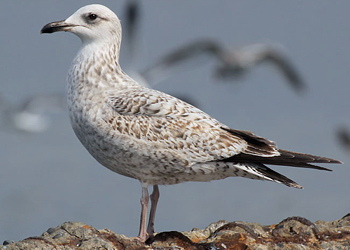 |
 |
| Vega Gull (vegae), 1st cycle, March 28 2009, Choshi, Japan (Akimichi Ariga). Due to thin lining in the anchor shapes on the scapulars, the overall colour of the back is rather pale in this bird. |
Herring Gull (argentatus) 1st cycle JL6Z February 05 2005, Norway (Nils Helge Lorenzen). Classic bird showing dark anchor patterns on 2nd gen scaps (no plain grey scaps) and deep notching on coverts and on tertial fringes. Moult in body and head: delicate head streaking 'pencil streaks', not blotchy and greyish on flanks (contrasting with juvenile brown belly). Underparts not solid or uniform. |
 |
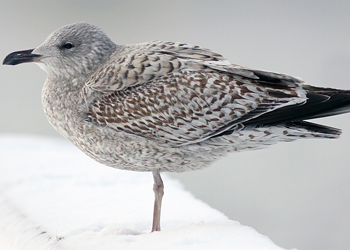 |
Vega Gull (vegae) 1st cycle, January 31 2010, Choshi, Japan (Gullog). Simple pattern of almost plain grey 2nd gen scaps. Also: no notching on tertial fringes and tertials darkest part of the bird (together with primaries) like in cachinnans / cach hybrids. Dark, rather solid patch on flanks, rather uniform underparts. Note: limited body moult (contra cachinnans). Atypical bird in a European context. |
Herring Gull argentatus, December 20 2009, Simrishamn, Sweden (Hans Larsson). All scaps replaced. Last acquired faethers (lwer scapulars) still with buffish tone.
When Herring Gull replace scaps early in fall, the common pattern is that of bold anchor shapes. Later in the season, the pattern can be thinner. This is illustrrated by this bird: the shaft streak in the lower scaps is thin, however the transversal bars are still pretty broad, and not a single greyish based feathers is moulted in. |
| |
|
| The plain grey 2nd generation scapulars commonly seen in Vega Gull are reminiscent of European cachinnans or cachinnans hybrids, as ullustrated below. And also dark tertials with only thin pale straight fringes are common in cachinnans. Nonetheless, Vega Gull is unlikely misidentified for Caspian Gulls; fortunately, cachinnans has a very early and extensive post-juvenile moult, easily ruling out the Vega possibilties in such birds. |
 |
 |
Vega Gull (vegae) 1st cycle, January 31 2010, Choshi, Japan (Gullog). Note: more solid dark area on ear coverts running up behind the eye to the crown. Note too: several 2nd gen scaps are almost plain grey.
Rather plain feathers are commonly found in cachinnans; the anchor patterns on 2nd gen scaps in European Herring Gulls are much bolder and pronounced.Except for these grey scapulars, this bird is very similar to European Herring Gull. |
Caspian Gull (cachinnans) hybrid 1st cycle VP9Y December 12 2012, København, Denmark (Lars Krogh). Ringed in Denmark, showing rear scaps with grey base and just a black shaft streak. |

|
 |
| Vega Gull (vegae) 1st cycle, January 21 2012, Choshi, Japan (Seichoudoku). Paler bird; last acquired scaps plain greyish with darker shaft streaks (lower scaps). |
Caspian Gull (cachinnans) hybrid 1st cycle PLG DN-21230 December 05 2007, Minden, Germany (Armin Deutsch). Parents known as Herring (mother) and Caspian (father). Caspian-like greater-covert and tertial patterns, and replaced wing-coverts. Extensive body and head moult to 2nd gen (grey based feathers, contrasting to old juvenile brown washed feathers). |
 |
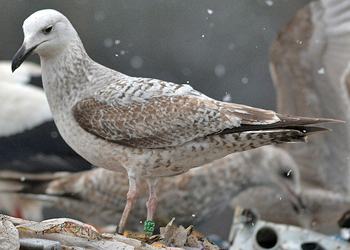 |
| Caspian Gull (cachinnans) hybrid 1st cycle 92P1 January 19 2007, Minden, Germany (Armin Deutsch). It shares the tertial pattern and some plain grey scaps with Vega, but it has extensive body moult. |
Caspian Gull (cachinnans) hybrid 1st cycle P463 March 21 2013, Minden, Germany (Armin Deutsch). It shares the tertial pattern and some plain grey scaps with Vega, but it has extensive body moult, barred flanks and a white head with delicate streaking, not blotchy. |
| |
|
- tertials with only narrow fringes and darker than the brown tone in the coverts in 1st cycle Vega Gull.
In Vega Gull, the tertials are often obviously dark brown, darker than the brown tone in the coverts and darker than retained juvenile scapulars. Overall the tertials are normally the darkest part of the back (but still paler than the blackish-brown primaries and tail-band). In European Herring Gulls the brown centres of tertials are less contrasting to the coverts.
The pattern on the tertials in Vega is often is simple, with only narrow pale fringes, lacking deep notching as in most Herring Gulls and in Vega also a pale tip with thin anchor pattern. However, tertial patterns in Herring gulls are variable and simple patterns do occur sometimes (see image below, right; especially Baltic Herring Gulls seem to show straight pale lines in the tertial fringes more often?). |
 |
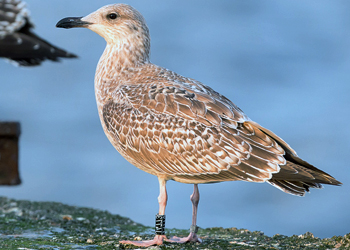 |
Vega Gull (vegae) 1st cycle, January 31 2010, Choshi, Japan (Gullog). Note very weak anchor pattern on 2nd gen scaps and note pattern on the tertials: they are darker brown than coverts and they lack the post-stamp notches. |
Herring Gull (argentatus) 1st cycle J4773 December 12-13 2013, Sandøya, Norway (Ingar Støyle Bringsvor). Some Herring Gulls may lack notching in the tertial fringes. |
| |
|
- uniform underparts and solid dark flanks in 1st cycle Vega Gull.
1st cycle Vega Gull may show uniform underparts, more in line with American Herring Gull smithsonianus, than with European Herring Gull. In European Herring Gulls the heavier marked flanks and belly are lined and mottled with blotchy bold patterning, not solid dark as the images below illustrate. |
 |
 |
Vega Gull (vegae) 1st cycle, January 31 2010, Choshi, Japan (Gullog). Simple pattern of almost plain grey 2nd gen scaps. Dark, rather solid patch on flanks, rather uniform underparts. Note: limited body moult. Ideally, Vega Gull also shows a neat uniform chest and belly. |
Herring Gull (argentatus) 1st cycle J0AG February 05 2005, Norway (Nils Helge Lorenzen). Moult in body and head: delicate 'pencil streaks' on head. Underparts not solid or uniform, but lined. Tertials not obviously darker than brown tone of coverts. |
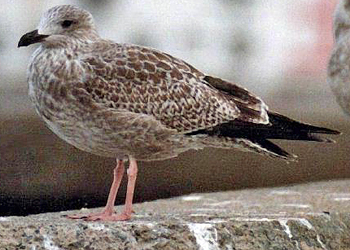 |
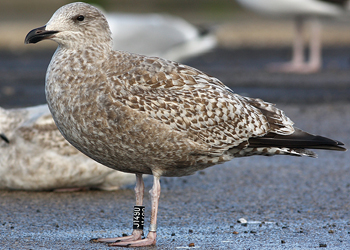 |
| Vega Gull (vegae), 1st cycle (2CY), January 2000, Choshi Chiba, Japan. Picture: Michiaki Ujihara. In juvenile plumage with dark patch on flanks. Note dark tail and limited notching in tertial fringes. |
Herring Gull (argentatus) 1st cycle J1490 November 27 2011, Boulogne-sur-Mer, NW France (Jean-Michel Sauvage). From Finnmark, Norway (70°23'N). Streaked chest and underparts not uniform brown; flanks not obviously different in brown tone. Such northern birds show limited post-juvenile moult. |
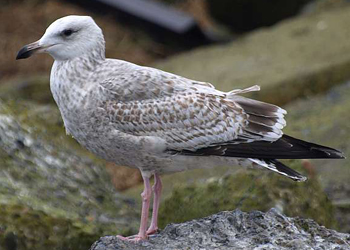 |
 |
| Vega Gull (vegae), 1st cycle, January 21 2012, Choshi, Japan (Seichoudoku). Not all Vega Gull are solidly patterned on underparts, some are obviously pale and marbled. Tertials with anchor shape on the tips. Rich pink legs. |
Herring Gull (argenteus) 1st cycle R.0 September 23 2013, Katwijk, the Netherlands (Mars Muusse). Some Herring Gulls are darker, but generally darker overall, and therefore the patch on the flanks does not stand out as darker than the underparts. |
| |
|
- rectrices with broader dark bands in Vega Gull.
In Vega Gull the outer tail-feather R6 normally shows proximal barring and flecking. European Herring Gull has a narrower dark tail band and the proximal half of R6 is normally clean white or with single black spots. However, there is variation in this aspect, ad the images below show Herring Gulls in the darker end of the spectrum regarding lining and flecking on R6. |
 |
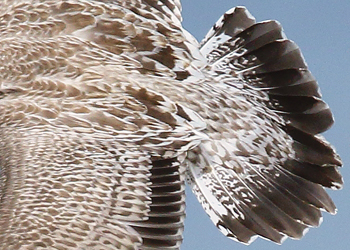 |
Vega Gull (vegae) 1st cycle, January 27 2011, Choshi, Japan (Terry Townshend). Broad tail band, outermost tail-feather R6 with proximal spotting on both inner and outer web. |
Herring Gull (argenteus) 1st cycle, September 14 2015, Katwijk, the Netherlands (Mars Muusse). About average bird: limited proximal barring in outer rectrices. |
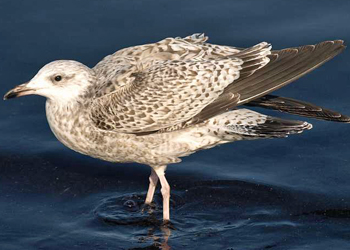 |
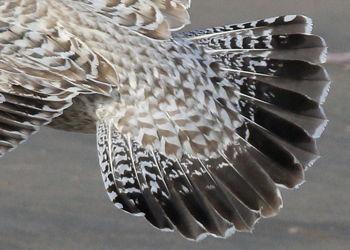 |
Vega Gull (vegae) 1st cycle, January 28 2012, Choshi, Japan (Seichoudoku). Broad tail band, outermost tail-feather R6 with proximal spotting on both inner and outer web. |
Herring Gull 1st cycle, November 12 2015, Katwijk, the Netherlands (Mars Muusse). Bird showing more than average proximal flecking in outer rectrices. |
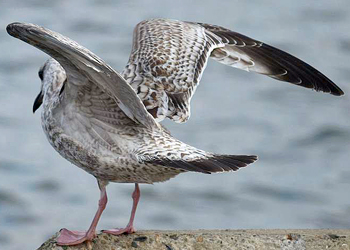 |
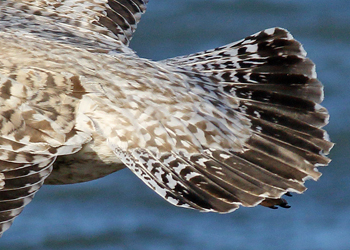 |
| Vega Gull (vegae), 1st cycle (1CY), November 26 2011, Choshi, Japan. Picture: Seichoudoku. Much spots on outermost rectrices and overall broad tail-band. |
Herring Gull 1st cycle, December 042015, Scheveningen, the Netherlands (Mars Muusse). Bird showing more than average proximal flecking in outer rectrices. |
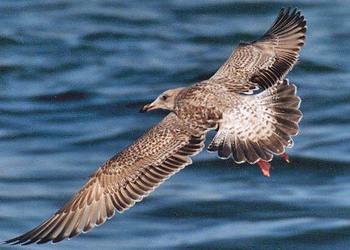 |
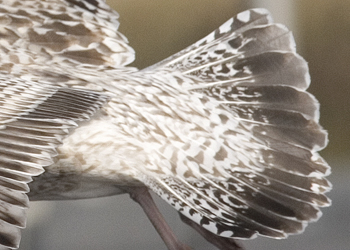 |
| Vega Gull (vegae), 1st cycle (1CY), December 22 2000, Choshi Chiba, Japan (Michiaki Ujihara). Largely dark tail with much lining and speckling in outermost tail-feather R6. |
Herring Gull (argenteus) 1st cycle, September 17 2013, Katwijk, the Netherlands (Mars Muusse). Bird showing more than average proximal flecking in outer rectrices. |
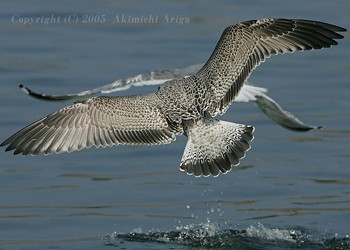
|
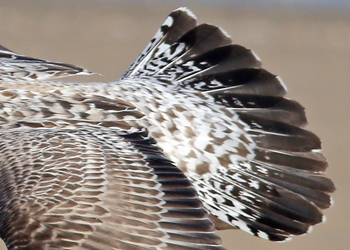 |
| Vega Gull (vegae), 1st cycle, October 28 2005, Choshi, Japan. Picture: Akimichi Ariga. This bird's tail-band approaches that of European Herring gulls. |
Herring Gull 1st cycle, October 13 2015, Katwijk, the Netherlands (Mars Muusse). Bird showing more than average proximal flecking in outer rectrices. |
| |
|
- dark patch on head most solid on rear ear-coverts to crown in Vega Gull.
(delicately streaked crown in European Herrings, especially when head feathers have been moulted to 2nd generation the streaking appears as fine pencil lines); |
 |
 |
| Vega Gull (vegae) 1st cycle, January 31 2010, Choshi, Japan (Gullog). Solid dark area on ear coverts running up behind the eye to the crown. Note too: several 2nd gen scaps are almost plain grey. Rather plain feathers are commonly found in cachinnans; the anchor patterns on 2nd gen scaps in European Herring Gulls are much bolder and pronounced. Except for these grey scapulars, this bird is very similar to European Herring Gull. |
Herring Gull (argenteus) 1st cycle 429 November 15 2006, Oostende, Belgium (alther Leers). It's difficult to find Herring Gulls with solidly dark ear coverts, but this bird is a close match. Fine streaking is the norm in Herrings. |
 |
 |
Vega Gull (vegae) 1st cycle, January 31 2010, Choshi, Japan (Gullog). Ear coverts may be pale in Vega as well. Grey-brown base of scaps suggest these feathers were replaced quite recently, and still not bleached. |
Herring Gull (argentatus) 1st cycle KV48 December 31 2006, Oostende, Belgium (Francois Roland). From Murmansk (67.05 N). Probably female. |
| |
|
- obvious pale panel on inner primaries, also on outerwebs in Vega Gull.
Pale window on inner primaries very prominent in Vega Gull, sometimes the window continues on the outermost secondaries and on the inner greater primary coverts. Window continues on innerwebs of central primaries, still obvious pale innerwebs on P5-P6. |
 |
 |
| Vega Gull (vegae) 1st cycle, January 25 2011, Choshi, Japan (Terry Townshend). Dark secondary bar. Pale panel on inner primaries reaching outer secondaries S1-S3 and still innerweb of P6 largely pale. |
Herring Gull 2cy, January 23 2013, Katwijk, the Netherlands (Mars Muusse). Showing pattern on 1st gen inner primaries. |
 |
 |
Vega Gull (vegae) 1st cycle, January 27 2011, Choshi, Japan (Terry Townshend). Very similar to European Herring Gull. 1st gen flight feathers. Tail pattern typical. Beginning to gain some grey scapulars. |
Herring Gull argentatus 1st cycle, December 03 2013, Katwijk, the Netherlands (Mars Muusse). Showing upperwing and tail pattern. No scaps replaced. |
| |
|
- tidy and pale looking wing-coverts and juvenile scapulars in Vega Gull.
The wing-coverts in Vega Gull seem paler and very neat and tidy patterned compared to the darker and quite messy ones in Herring Gulls. Below are two example Herring Gulls closely matching Vega regarding silvery white greater covert bars. However, bird C5Y8, although with much white in greater coverts, does not repeat that pattern on the lower lesser coverts. Bird ES14266 really comes close to Vega's standards, but is obvious different on underparts. |
 |
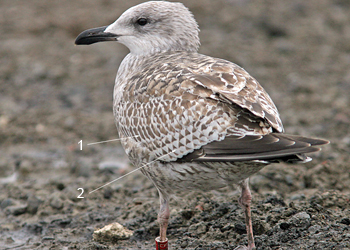 |
Vega Gull (vegae) 1st cycle, January 31 2010, Choshi, Japan (Gullog). Neat, precise and largely silvery white pattern on both greater (2) and lower lesser (1) coverts. |
Herring Gull (argentatus) 1st cycle C5Y8 October 30 2005, Tampere, Finland (Hannu Koskinen). Here: tidy and largely pale greater coverts (2), but extensive dark centres in lowqer lesser coverts (1). |
 |
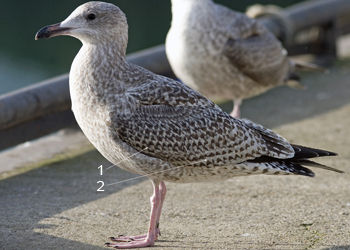 |
Vega Gull (vegae) 1st cycle, November 26 2011, Choshi, Japan (Seichoudoku). Neat and largely silvery white pattern on both greater (2) and lower lesser (1) coverts. They seem paler and very neat and tidy patterned compared to the darker and quite messy ones in Herring Gull. |
Herring Gull (argentatus) 1st cycle RUM ES14266 October 22 2012, Scheveningen, the Netherlands (Mars Muusse). Hatched in N. Russia, Kandalakshskiy NP (67.07 N). Example of a more tidy Herring Gull, closely matching the tidy pattern on coverts and juvenile scapulars. |
| |
|
- bright pink legs in Vega Gull.
The leg color on Herring Gull is dull greyish pink or flesh coloured. The deep reddish tone on legs is unusual in Herring Gulls; normally they are duller with a greyish tinge. |
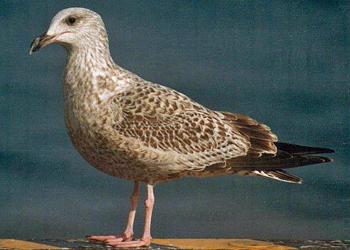 |
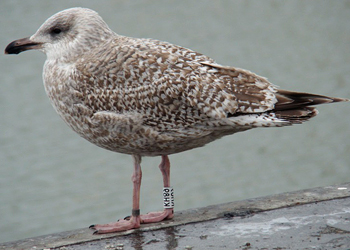 |
| Vega Gull (vegae), 1st cycle, December 02 2000, Choshi Chiba, Japan (Michiaki Ujihara). Right raspberry pink legs. Tertials obviously darker brown than brown tone in coverts and no notching in tertial fringes. Scapulars replaced for 2nd gen feathers, all with rather bold transversal bands in the anchor pattern, much like Herring Gull argentatus. Bird not really blotchy in the neck and on the breast (many neck feathers replaced), and also several feathers on flank replaced. Note dark tail. Except for the tertial pattern, this is a difficult bird in a European context. |
Herring Gull argentatus KH89 January 23 2010, IJmuiden, the Netherlands. Hatched in Murmansk N Russia (67.05N). An example Herring Gull with rich pink legs. Despite most Herrings show dull flesh coloured legs, more saturated pink legs do occur in Herring Gull as well. |
| |
|
Multiple features in one bird - doable 1st cycle Vega Gull?
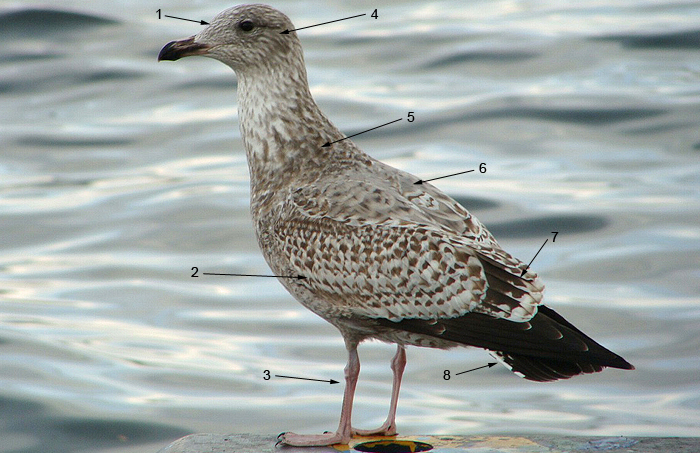
Bird with dark streaked forehead (1), largely white on wing-coverts, including outer coverts like lower lesser coverts (2), with raspberry pink legs (3), solid dark on the ear-coverts (4), very blotchy patterned in the neck, running down to the side of the breast (5), scapulars replaced late in the season containing a few plain grey feathers with just a dark shaft streak (6), limited white on the fringes of the tertials (and an anchor-shaped pattern on the tip (7), and showing a broad tail-band with much proximal black spotting and lining in the outer rectrices as well (8). Could any European Herring Gull match such a bird?
A discussion bird in the US can be found on the blog of Kirk Zufelt.
CONTINUE 2nd CYCLE & IMMATURE BIRDS
CONTINUE ADULT BIRDS |
 Vega Gull (vegae), 1st cycle (1CY), date: location: photographer. Vega Gull (vegae), 1st cycle (1CY), date: location: photographer. |
 Vega Gull (vegae)
Vega Gull (vegae)  / セグロカモメ
/ セグロカモメ  / 재갈매기
/ 재갈매기 
 Vega Gull (vegae), 1st cycle (1CY), date: location: photographer.
Vega Gull (vegae), 1st cycle (1CY), date: location: photographer.






































